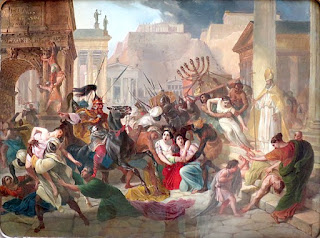"Garbage" refers to, basically, kitchen scraps: the things you would normally take out of or off the food you were preparing to serve. Here is a 15th century recipe called "Garbage" (my translation):
Take garbage of chickens, as the head, the feet, the livers, and the gizzards; wash them clean, and cast them in a pot, and cast thereto fresh broth of beef or else of mutton, and let it boil; and ally it with bread, and lay on pepper and saffron, mace, cloves, and a little verjuice [juice of unripe grapes or apples] and salt, and serve as a stew.
Okay, more of a bowl than a plate, but you get the idea.
Le Ménagier de Paris ("The Parisian Household Book") from 1393 is a guide to a women's management of her household. It includes a recipe for squirrel (translation by Jane Hinson; original text here):
Squirrels are singed, gutted, trussed like rabbits, roasted or put in pastry: eat with cameline sauce or in pastry with wild duck sauce.
What could be simpler? (cameline was a sauce of cinnamon) There were different kinds of cinnamon, and we don't always know which was used in old recipes; a discussion of them can be found here.
The idea that spices were used to cover the taste of rotting meat needs to be discussed, since no spice would prevent the ill effects of consuming rotten meat! It is ridiculous to assume that techniques for preserving meat have not existed for thousands of years. Drying, smoking, salting (and in extreme northern climes simply burying in the snow) were available methods of extending the "shelf life" of meat. The salting method meant re-hydrating, and this excellent website offers a modern experiment on the process with venison. The author notes at the end that the version is still a little salty and the process was tedious, but I imagine in the Middle Ages he would have had a servant to manage the process of rehydrating, which would have resolved both those issues.
If you want a Catalan recipe for roast cat from a 1520 cookbook (which I will not print here for the sake of any readers who like cats), go here and search for recipe number 123.
One more, from a 1400s German cookbook, tells us of the health benefits of hedgehogs:
The meat of a hedgehog is good for lepers. Those who dry its intestines and grind them to a powder and eat a little of that are made to piss, even if they can not do so otherwise.
Well, since we are on the subject of hedgehog (also from Le Ménagier de Paris):
Hedgehog should have its throat cut, be singed and gutted, then trussed like a pullet, then pressed in a towel until very dry; and then roast it and eat with cameline sauce, or in pastry with wild duck sauce. Note that if the hedgehog refuses to unroll, put it in hot water, and then it will straighten itself.
These are some culinary bits and pieces that you probably have not seen before. There are numerous websites and books that cover medieval cookery. One of the most thoroughly informative is www.medievalcookery.com. I highly recommend it for its information and the erudition of its creator. There has not been an update to it in almost two years, and the contact link created a 404 error, so I do not know if the creator is still managing it regularly. Even without updates, it is a treasure trove.
As promised, next we will talk about medieval use of grains.
























